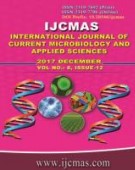


 National Academy of Agricultural Sciences (NAAS)
National Academy of Agricultural Sciences (NAAS)

|
PRINT ISSN : 2319-7692
Online ISSN : 2319-7706 Issues : 12 per year Publisher : Excellent Publishers Email : editorijcmas@gmail.com / submit@ijcmas.com Editor-in-chief: Dr.M.Prakash Index Copernicus ICV 2018: 95.39 NAAS RATING 2020: 5.38 |
Erwinia chrysanthemi is the causal agent of soft rot of Aloe vera. In the present study, 51 isolates of Erwinia chrysanthemi of Aloe vera from Tamilnadu were characterized. Molecular detection of Erwinia chrysanthemi was carried out using species specific primers and toxin analysis was carried out using PCR and HPTLC analysis. Morphological identifications were well correlated with the molecular detection method. All the 51 isolates expressed an amplified product size of approximately 560 bp and hence confirmed as P. fluorescens. One isolate which expressed an amplified produce approximately 546 bp was confirmed as Bacillus subtilis. The crude antibiotics, viz., phenazine and 2, 4 diacetylphloroglucinol (DAPG) extracted from Pf 32, Pf 45 and Bs5 respectively, were thermostable (1000C) and highly anti-bacterial against E. chrysanthemi. The presence of Phenazine and DAPG was detected through thin layer chromatography (TLC) with an Rf value of 0.57 for the isolates Pf 32, Pf 45 and Pf 4 and for DAPG the Rf value 0.88 was detected for the isolates Pf 32 and Pf 45. Primers Phl2a and Phl2b amplified the predicted size of 745 bp fragment from the genomic DNA of Ph 1 producing Pseudomonas isolates Pf 32 and Pf 45. Primers PCA 2a and PCA 2b amplified the predicted 1,150 bp fragment from genomic DNA of Pseudomonas sp Pf 32 and Pf 45.
 |
 |
 |
 |
 |